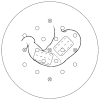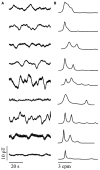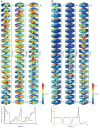Biomagnetic signatures of uncoupled gastric musculature
- PMID: 19222760
- PMCID: PMC2855967
- DOI: 10.1111/j.1365-2982.2009.01265.x
Biomagnetic signatures of uncoupled gastric musculature
Abstract
Gastric slow waves propagate in the electrical syncytium of the healthy stomach, being generated at a rate of approximately three times per minute in a pacemaker region along the greater curvature of the antrum and propagating distally towards the pylorus. Disease states are known to alter the normal gastric slow wave. Recent studies have suggested the use of biomagnetic techniques for assessing parameters of the gastric slow wave that have potential diagnostic significance. We present a study in which the gastric syncytium was uncoupled by mechanical division as we recorded serosal electric potentials along with multichannel biomagnetic signals and cutaneous potentials. By computing the surface current density (SCD) from multichannel biomagnetic recordings, we were able to quantify gastric slow wave propagation as well as the frequency and amplitude of the slow wave and to show that these correlate well with similar parameters from serosal electrodes. We found the dominant slow wave frequency to be an unreliable indicator of gastric uncoupling as uncoupling results in the appearance of multiple slow wave sources at various frequencies in external recordings. The percentage of power distributed in specific frequency ranges exhibited significant postdivision changes. Propagation velocity determined from SCD maps was a weak indicator of uncoupling in this work; we believe that the relatively low spatial resolution of our 19-channel biomagnetometer confounds the characterization of spatial variations in slow wave propagation velocities. Nonetheless, the biomagnetic technique represents a non-invasive method for accurate determination of clinically significant parameters of the gastric slow wave.
Figures






Similar articles
-
Surface current density mapping for identification of gastric slow wave propagation.IEEE Trans Biomed Eng. 2009 Aug;56(8):2131-9. doi: 10.1109/TBME.2009.2021576. Epub 2009 Apr 28. IEEE Trans Biomed Eng. 2009. PMID: 19403355 Free PMC article.
-
Biomagnetic characterization of spatiotemporal parameters of the gastric slow wave.Neurogastroenterol Motil. 2006 Aug;18(8):619-31. doi: 10.1111/j.1365-2982.2006.00794.x. Neurogastroenterol Motil. 2006. PMID: 16918726
-
Rapid high-amplitude circumferential slow wave propagation during normal gastric pacemaking and dysrhythmias.Neurogastroenterol Motil. 2012 Jul;24(7):e299-312. doi: 10.1111/j.1365-2982.2012.01932.x. Neurogastroenterol Motil. 2012. PMID: 22709238 Free PMC article.
-
Electrogastrography: basic knowledge, recording, processing and its clinical applications.J Gastroenterol Hepatol. 2005 Apr;20(4):502-16. doi: 10.1111/j.1440-1746.2004.03751.x. J Gastroenterol Hepatol. 2005. PMID: 15836697 Review.
-
Electrical events underlying organized myogenic contractions of the guinea pig stomach.J Physiol. 2006 Nov 1;576(Pt 3):659-65. doi: 10.1113/jphysiol.2006.116491. Epub 2006 Jul 27. J Physiol. 2006. PMID: 16873400 Free PMC article. Review.
Cited by
-
Gastric motility physiology and surgical intervention.Surg Clin North Am. 2011 Oct;91(5):983-99. doi: 10.1016/j.suc.2011.06.012. Surg Clin North Am. 2011. PMID: 21889025 Free PMC article. Review.
-
Diabetic gastroparesis alters the biomagnetic signature of the gastric slow wave.Neurogastroenterol Motil. 2016 Jun;28(6):837-48. doi: 10.1111/nmo.12780. Epub 2016 Feb 3. Neurogastroenterol Motil. 2016. PMID: 26839980 Free PMC article.
-
Simultaneous anterior and posterior serosal mapping of gastric slow-wave dysrhythmias induced by vasopressin.Exp Physiol. 2016 Sep 1;101(9):1206-1217. doi: 10.1113/EP085697. Epub 2016 Jul 26. Exp Physiol. 2016. PMID: 27265885 Free PMC article.
-
Effects of volume conductor and source configuration on simulated magnetogastrograms.Phys Med Biol. 2010 Nov 21;55(22):6881-95. doi: 10.1088/0031-9155/55/22/018. Epub 2010 Nov 3. Phys Med Biol. 2010. PMID: 21048291 Free PMC article.
-
The virtual intestine: in silico modeling of small intestinal electrophysiology and motility and the applications.Wiley Interdiscip Rev Syst Biol Med. 2016 Jan-Feb;8(1):69-85. doi: 10.1002/wsbm.1324. Epub 2015 Nov 12. Wiley Interdiscip Rev Syst Biol Med. 2016. PMID: 26562482 Free PMC article. Review.
References
-
- Stevens RJ, Weinert JS, Publicover NG. Visualization of origins, propagation of excitation in canine gastric smooth muscle. Am J Physiol. 1999;1:C448–60. - PubMed
-
- Simonian HP, Panganamamula K, Parkman HP, et al. Multichannel electrogastrography (EGG) in normal subjects: a multicenter study. Dig Dis Sci. 2004;49:594–601. - PubMed
-
- Zhang H, Xu X, Wang Z, Li C, Ke M. Correlation between gastric myoelectrical activity recorded by multi-channel electrogastrography and gastric emptying in patients with functional dyspepsia. Scand J Gastroenterol. 2006;41:797–804. - PubMed
-
- Levy J. Use of electrogastrography in children. Curr Gastroenterol Rep. 2002;4:259–65. - PubMed
Publication types
MeSH terms
Grants and funding
LinkOut - more resources
Full Text Sources

